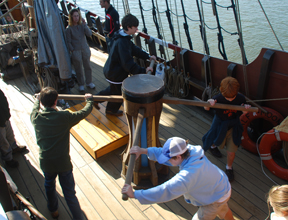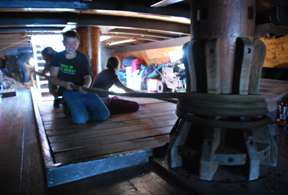 |
|
|
Mouse over to walk the capstan.
 |
Mechanical advantage is the ratio of output force divided by input force in a simple machine, such as a pulley, lever, or winch. The greater a machine's mechanical advantage, the greater its output force compared to its input force. In other words, simple machines with positive mechanical advantage make it easier to lift or move heavy objects.
|
Mouse over to tend the anchor rode.
 |
We use simple machines all over the Half Moon in a wide variety of forms and uses. For example, our capstan (upper half pictured above; lower half pictured left) is a massive winch used for lifting tasks such as weighing anchor. The anchor alone weighs 300 lbs., while the total load on the capstan while weighing anchor (including the anchor, chain, line, and the strain of pulling the ship against the current) can approach a ton. Despite this, with the capstan's help, just eight students can raise our anchor without a problem (though certainly not without effort!).
|

In the helm hutch, we use a whipstaff to steer the ship; the original Half Moon predates wide use of the ship's wheel by about a century. The whipstaff is a simple lever, allowing a single crewmember to easily push the ship's massive rudder and tiller to back and forth.
Above the ship, we use dozens of blocks (pulleys) in the rigging to handle the sails. The lateen sail alone, our simplest sail, uses more than twenty!
|

For our experiments in mechanical advantage, we rigged a block-and-tackle system designed to lift a lead ballast ingot (safely wrapped in canvas) a few inches off the deck, using from one to four pulleys to distribute the load. As Jena and Natalie haul on the line, a spring scale measures how many pounds of force must be exerted to lift the weight. As an interesting side wrinkle, our spring scale can only measure up to 50 pounds, and the ingot weighs considerably more. Thus, Jena and Natalie must extrapolate the ingot's true weight from their findings.
In theory, each down-pulling pulley doubles this simple machine's mechanical advantage. In practice, however, the friction of the lines and pulleys counteract this advantage. The effect of friction is negligable at first, but it gradually increases as more pulleys are added, ultimately canceling out any mechanical advantage gained -- thus placing limits on the machine's effectiveness, no matter how many additional pulleys are added.
|
|
|
| |
|
|